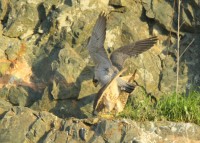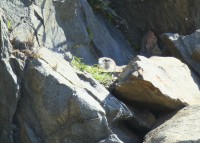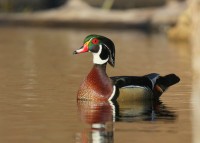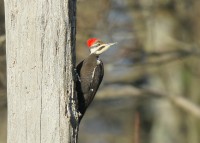Great Horned Owl on nest!
April 24, 2016 in Great Horned Owl
April 24, 2016 in Great Horned Owl
April 21, 2016 in Great Horned Owl
April 21, 2016 in Peregrine Falcon Woburn
April 20, 2016 in Great Horned Owl
April 20, 2016 in Peregrine Falcon Woburn
April 18, 2016 in Peregrine Falcon Woburn
 Made an early visit to observe the Woburn Falcons and found the female hunkered down in incubation mode. She may have laid one or two eggs at this point. Also had a chance to observe further copulation activity. Typically the copulation activity ends after the third egg is laid, so we may be close to the end of the egg laying cycle!
Made an early visit to observe the Woburn Falcons and found the female hunkered down in incubation mode. She may have laid one or two eggs at this point. Also had a chance to observe further copulation activity. Typically the copulation activity ends after the third egg is laid, so we may be close to the end of the egg laying cycle!
April 16, 2016 in Peregrine Falcon Woburn
 After months of speculation among the local peregrine watchers about whether these falcon would form a pair bond; and after many weeks of observed and reported copulation activity between the unbanded male, and the not quite yet one year old banded female, it looks very much like the first eggs have been laid and the the incubation process has started.
After months of speculation among the local peregrine watchers about whether these falcon would form a pair bond; and after many weeks of observed and reported copulation activity between the unbanded male, and the not quite yet one year old banded female, it looks very much like the first eggs have been laid and the the incubation process has started.
With Peregrine Falcons, it is normal for first-time egg layers to start a bit later in the season. The eggs are laid normally about 48 hours apart, but it can be as long as 72 hours apart. Usually, full-time incubation starts after the second to last (penultimate) egg has been laid. In many nests, the female handles the incubation duties around 2/3’s of the total time with the male taking up the balance and providing the female with time off the nest.
April 16, 2016 in Nearby Waterbirds
 Wood Ducks are being seen in many lakes and ponds in Essex County. The beautiful male Wood Ducks are considered by many to be the most striking and colorful of all North American ducks. Their brightly colored plumage and stunning red eyes make for a memorable sight! Unlike most other ducks, the Wood ducks are known for raising two broods per season! This Wood Duck was recently seen at the Ward Reservation in Andover.
Wood Ducks are being seen in many lakes and ponds in Essex County. The beautiful male Wood Ducks are considered by many to be the most striking and colorful of all North American ducks. Their brightly colored plumage and stunning red eyes make for a memorable sight! Unlike most other ducks, the Wood ducks are known for raising two broods per season! This Wood Duck was recently seen at the Ward Reservation in Andover.
April 16, 2016 in Nearby Landbirds
 The Pileated Woodpecker is a rare treat and a great find. Observed this Pileated in the Ward Reservation in Andover as it moved among many of the the tree trunks around open and still swamp water. The Pileated is the largest woodpecker in North America and is easily identified by its oversized bright red crest. The Pileated remains on territory year round!
The Pileated Woodpecker is a rare treat and a great find. Observed this Pileated in the Ward Reservation in Andover as it moved among many of the the tree trunks around open and still swamp water. The Pileated is the largest woodpecker in North America and is easily identified by its oversized bright red crest. The Pileated remains on territory year round!
April 16, 2016 in Nearby Landbirds